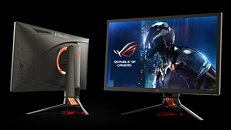Thursday, March 22nd 2018

NVIDIA Expects Partners to Release 4K, 144 Hz G-Sync Displays With HDR in April
Reports have started doing the rounds that users might finally see NVIDIA's dream for 4K, 144 Hz gaming come to fruition as early as next month. NVIDIA's approach towards establishing a platform of a premium 4K gaming experience meant that manufacturers - of which ASUS and Acer are two of the foremost examples for this story - were forced to opt for a single panel solution, based on AU Optronics' M270QAN02.2 AHVA panel. This is because NVIDIA wanted gamers to be treated to a fully integrated solution, that boasted of features such as 3840×2160 resolution, a 144 Hz refresh rate, a 1000-nits brightness, a direct LED backlighting system with 384 zones, and feature a quantum dot film to enable HDR10 and coverage of the DCI-P3 color gamut.
However, with such stringent requirements, NVIDIA monitor partners would have to accept what constraints might arise from the panel manufacturer's side of the equation, which ultimately, resulted in a delay for the manufacturer's models - Acer Predator X27 and ASUS ROG Swift PG27UQ - from a 2017 release date to what is now expected to be a firm, April 2018 one. Gamers might thus be in for the impending release of some of the best monitors in the industry when it comes to a premium, high refresh-rate gaming experience. Now, where are those mainstream OLED panels with at least 900 nits brightness I wanted to get my hands on?
Source:
AnandTech
However, with such stringent requirements, NVIDIA monitor partners would have to accept what constraints might arise from the panel manufacturer's side of the equation, which ultimately, resulted in a delay for the manufacturer's models - Acer Predator X27 and ASUS ROG Swift PG27UQ - from a 2017 release date to what is now expected to be a firm, April 2018 one. Gamers might thus be in for the impending release of some of the best monitors in the industry when it comes to a premium, high refresh-rate gaming experience. Now, where are those mainstream OLED panels with at least 900 nits brightness I wanted to get my hands on?


64 Comments on NVIDIA Expects Partners to Release 4K, 144 Hz G-Sync Displays With HDR in April
120hz
120hz ULMB
not sure how that isn't noticeable to you........
www.blurbusters.com/faq/60vs120vslb/there was a video of a guy demonstrating it with a game. I dont recall where. This was about a year ago I remember someone posting about a video they found of this guy glitching the 2 to work together. Either here or hardforum i saw the youtube video being posted.
I don't notice it in game, maybe my eyes don't see 200 fps as do yours? after all i am getting old :(
The bluring is very obvious....you just have to pay attention. It is the same thing as an none calibrated screen. Once you see the difference its obvious.
Video games look as bad as they screen shots if you pay attention hence why i use ULMB 24/7
thanks for the info, you seem to know what you are talking about.
1080p - 23.6 - 24"
1440p - 27"
2160p - 40"
2. If you have the GFX horsepower, you can use ULMB ... unfortunately, the GFX card industry has some catching up to do as today's top games are pushing 4k fps down to the mif 40s even with a 1080 Ti. But if you can afford this screen, you won't blink at getting a 2nd Ti ... scaling on the 10xx series (including games with no SLI support) averages only 50% but that will insure 60+ in everything I have seen so far.
3. I keep seeing posts pushing the faster screen needs bigger cards even if ya not at full range thing, but I have not seen a significant impact on fps with monitors at 120 Mhz or 144 or 165 hz when game fps is in the 80s.
4. I don't see freesync as a relevant issue here for one big reason ... despite most perceptions, they are not the same thing as G-Sync comes w/ a hardware module to provide motion blur reduction and Freesync does not. G-Sync and Freesysnc are great for < 70 fps and while they continue to have an effect above 70 hz, the impacts fades fast. This link is a great way to see the effects of motion blur ... soccer ball option makes it most apparent i think
frames-per-second.appspot.com/
5. I really don't get the sandbagging comment ... With the last few generations of cards, nVidia has really been pushing limits according to TPUs game test suite.
1080 Ti was 57% faster than 980 Ti
980 Ti was 41% faster than 780 Ti
Hard to see a significant impact from Intel here going back 5-6 generations, we top out at 5% ... maybe ... from generation to generation
Tho I will say that is likely the case w/ SLI ... 10xx series performance is less than half what 9xx series was at 1440p and my guess is that's an attenmpt to stop the cannibalization of top tier card sales by twin x70s. Until AMD offers something to compete at the top tiers, I see this as a their means of getting more top tier card sales for which they make much higher margins.
6. I went 21:9 and I went back... I liked it initially for the sense of immersion but w/o that AU Optonics panel, colors appeared washed out and brightness was lacking. The size is nice, but not worth the reduction in panel quality.
7. I have yet to see a good "gaming TV"
If you play NS2 its ridiculously fast pace flick and shoot game. Clearer the image the better because when an alien is blurring across your screen....its hard to aim.
case in point
U:MB is massive difference.....